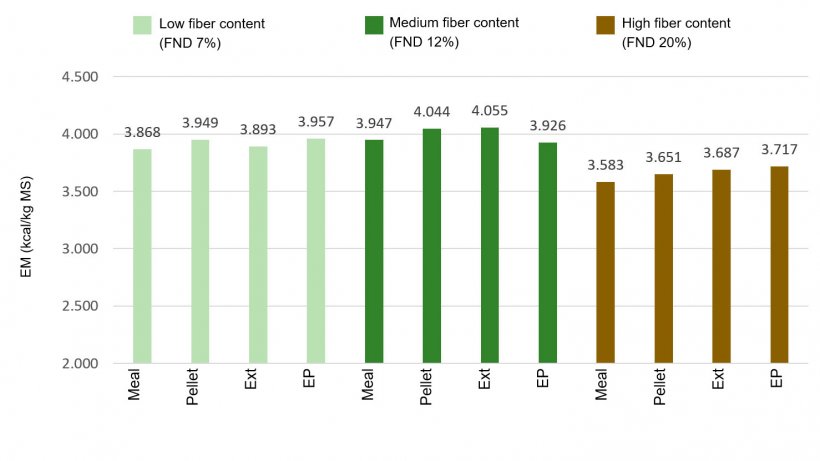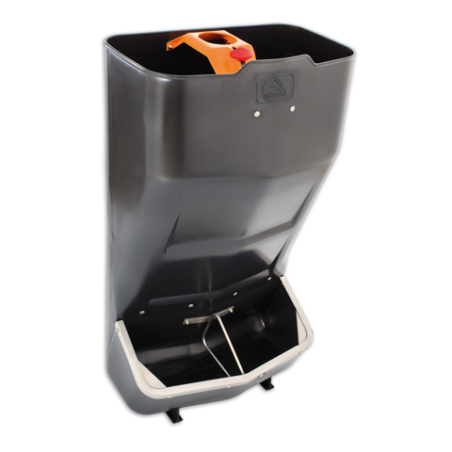In swine production, feed costs have large impact on total production costs. Maximizing nutrient utilization of the diet is part of the strategy to reduce the impact of high costs of raw materials
The hydrothermal treatment (conditioning with steam followed by compaction -pelleting- with or without expansion or extrusion) of pig diets results in the majority of cases in an improvement of the productive efficiency in both piglets and in the following stages of fattening. Rojas and Stein (2016) propose an improvement of the conversion rate that ranges from 4-12% as a result of the pelleting process of the diets compared to diets feed as meal. Table 1 lists some studies that illustrate these improvements.

Table 1. Effects of pelleting on the improvement of feed conversion ratio in piglets and fattening pigs
| Feed Conversion Ratio | ||||
| Reference | meal | pellet | dif. % | |
| Wondra et al., 1995 | fattening pigs | 3.37 | 3.14 | 6.6% |
| Millet et al., 2012 | fattening pigs | 2.58 | 2.45 | 5.0% |
| Xing et al, 2004 | piglets | 1.303 | 1.212 | 7.0% |
| Lundblat et al., 2011 | piglets | 1.32 | 1.23 | 6.8% |
| Ulens et al., 2015 | piglets | 1.54 | 1.29 | 16.1% |
The hydrothermal treatment of pig diets results in an improvement of the digestibility of energy and nutrients. Other positive effects are increased intake, especially in piglets, and a reduction in feed losses in hoppers and pits.
For most pigs the coefficient of digestibility of energy varies between 70-90%. Much of this variation is due to the presence of fiber in the diet: the more fiber the less digestibility of energy. Other factors of variation are the technological processing of the diets and the live weight or stage of development of the animal.
The pelleting process is considered to increase energy digestibility of the diet by an average of 1% although the improvement may be more important depending on the chemical and physical (particle size) properties of the diets. Noblet and Van Milgen (2004) showed that the improvement in digestibility when pelleting the diet was mainly due to an increase in fat digestibility (in diets with corn or full-fat rapeseed) and consequently the energy value of these ingredients depends on the technological treatment (Table 2).
Table 2. Effect of pelletting and particle size on digestibility coefficient (%) of fat and energy in growing pigs (from Noblet & van Milgen 2004).
| Item | Meal | Pellet | Abs. improvement |
| Corn-soybean diets | |||
| Fat | 61 | 77 | 16 |
| Energy | 88.4 | 90.3 | 1.9 |
| Wheat-soybean meal-full fat rapeseed diets (coarse grinding) | |||
| Fat | 27 | 84 | 57 |
| Energy | 73.1 | 87.4 | 14.3 |
| Wheat-soybean meal-full fat rapeseed diets (fine grinding) | |||
| Fat | 81 | 86 | 5 |
| Energy | 85.5 | 87.6 | 2.1 |
More intense processes such as expansion or extrusion with or without subsequent pelleting may have additional effects on productive efficiency. Lundblad et al (2012) found that a hydrothermal treatment improved the ileal digestibility of starch in pigs (29.5kg live weight) compared to meal diets and also increased ileal digestibility of some amino acids such as lysine, arginine, isoleucine and threonine. In the case of lysine, the improvement was superior in expanded and extruded diets than in only granulated diets.
The negative effects of high indigestible fiber content in the diets can be reduced with a pelleting treatment and accentuate this improvement with extrusion, resulting in a greater solubilization of dietary fiber and fermentation thereof.
Recently, the results of a study by Rojas et al (2016) comparing the effects of different hydrothermal processing intensities (meal, pelleting, extrusion and extrusion + pelleting) on three types of diets with low, medium and high levels of dietary fiber in growing pigs allow to conclude that:
-
Hydrothermal processing improves the ileal digestibility of starch and most of the indispensable amino acids, without significant differences between pelleting and extrusion.
-
Pelleting improves energy digestibility in diets based on corn, soybeans and DDGS with low or medium fiber levels (FND 7-12%) and yet this improvement in diets based on corn, soybean, DDGS and soybean husks with a high fiber content (FND 20%) is only reached when the diets are subjected to more intense treatments, such as extrusion or extrusion + pelleting (Figure 1).

Conclusions

-
It is possible to increase the energy utilization in all types of diets through pelleting. However, in the case of high dietary fiber contents, the most significant improvement is achieved with extrusion.
-
The economic viability of these technologies depends on the cost of feed and the cost of equipment and energy consumption of such equipment.
Considerations for hydrothermal treatment
-
It should be noted that excessive heat treatment can cause Maillard reaction between the amino group of amino acids and the carbonyl group of reducing sugars, which reduces availability and digestibility of amino acids (Gonzales-Vega et al 2011).
-
Likewise, heating followed by fast cooling can lead to retrogradation of the starch, which can also reduce digestibility and thus its energy value. (Sauber and Owens, 2001)





